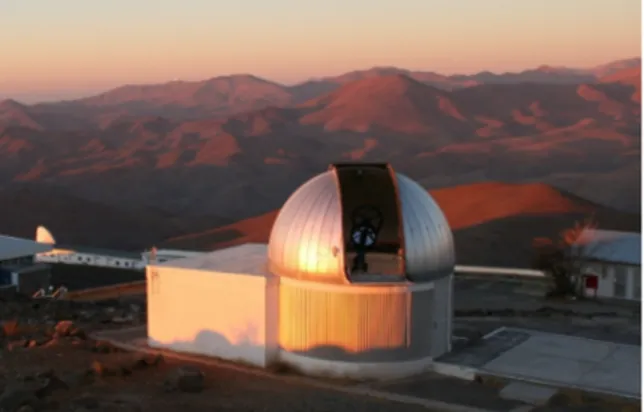TRAPPIST (TRAnsiting Planets and PlanetesImals Small
Telescope)
E. Jehin, M. Gillon, C. Opitom, J. Manfroid, D. Hutsemékers, L. Delrez, P. Magain
Département d'Astrophysique, de Géophysique et d'Océanographie, Université de Liège, Allée du six Août, 4000 Liège, Belgium (ejehin@ulg.ac.be)
Abstract
TRAPPIST is a 60-cm robotic telescope that has been installed in June 2010 at the ESO La Silla Observatory [1]. Operated from Liège (Belgium) it is devoted to the detection and characterisation of exoplanets and to the study of comets and other small bodies in the Solar System. We describe here the hardware and the goals of the project and give an overview of the comet production rates monitoring after three years of operations.
1. The TRAPPIST project
TRAPPIST (TRAnsiting Planets and PlanetesImals Small Telescope) is a project driven by the Astrophysics and Image Processing group (AIP) at the Department of Astrophysics, Geophysics and Oceanography (AGO) of the University of Liège (Belgium), in close collaboration with the Observatory of Geneva (Switzerland). The science goal of TRAPPIST is the study of planetary systems through two approaches: the detection and study of exoplanets and the study of comets, asteroids and TNO.
1.1 The telescope and observatory
TRAPPIST’s optical tube unit is a Ritchey-Chretien 0.6 meter telescope with a focal length of 4.8 meter. It is associated with a German equatorial mount that is, thanks to its direct drive system, extremely fast (up to 50 deg/sec), accurate (tracking accuracy without autoguider better than 10” in 10 min), and free of periodic error. The instrument is a Peltier-cooled commercial camera equipped with a Fairchild 3041 back-illuminated 2k × 2k chip. The pixel scale is 0.64”/pixel. Three read-out modes are available, the shortest read-out time being 2s. The total field of
view of the camera is 22’ × 22’. It is associated to a custom-made dual filter wheel. One of the filter wheel contains broad band filters for the exoplanet photometry (Johnson B, V, R, Cousins Ic, Sloan z′, and a special I+z filter), while the other contains the narrow-band NASA HB cometary filters (OH, UC, NH, CN, CO+, C3, CN, BC, C2 , GC, RC and a NaI
filter) [2].
The telescope is protected by a 5 meter diameter dome that was totally refurbished and automatized early 2010. The observatory is fully robotic and equipped with a weather station, an UPS and webcams.
Figure 1. TRAPPIST at ESO la Silla Observatory
2. Comet monitoring
For relatively bright comets (V < 12) we measure several times a week the gaseous production rates (using a Haser model) and the spatial distribution of several species among which OH, NH, CN, C2 and
C3 as well as ions like CO+. The dust production
rates (Afrho) and color of the dust are determined through four dust continuum bands (UC, BC, GC, RC). Such regular measurements are rare because of EPSC Abstracts
Vol. 8, EPSC2013-968, 2013
European Planetary Science Congress 2013 c
the lack of observing time on larger telescopes. Yet they are very valuable as they show how the gas production rate of each species evolves with respect to the distance to the Sun. Those observations allow to determine the composition of the comets and the chemical class to which they belong (rich or poor in carbon for instance [3]), possibly revealing the origin of those classes but also if there are some changes of the abundance ratios along the orbit (evolutionary effects). Indeed with half a dozen of comets observed each year - and as long as possible along their orbit -, this program will provide a good statistical sample after a few years. We will present the first results of this monitoring.
Thanks to the way the telescope is operated, follow-up of split comets and of special outburst events is possible right after an alert is given and can bring important information on the nature of comets, like for comet C/2010 G2 (Hill) in December 2011. In addition to providing the productions rates of the different species through a proper photometric calibration, image analysis can reveal coma features (jets, fans, tails), that can lead to the detection of active regions and measure the rotation period of the nucleus.
The monitoring is also useful to assess the gas and dust activity of a given comet in order to prepare more detailed observations with larger telescopes. Such data can be obtained at any time under request. Finally a dozen of faint comets (V < 20) are monitored once a week through B, V, Rc, Ic filters and magnitudes and positions are sent to the MPC.
Acknowledgements
E.J. and M.G. are Research Associate FNRS, C.O is FNRS Research Fellow, D.H. is Senior Research Associate at the FNRS, J.M. is Research Director of the FNRS, and P.M. is Professor.
We would like to thank David Schleicher from Lowell Observatory for having recovered and lent one complete set of NASA cometary filters.
References
[1] Jehin et al., The Messenger, 145, 2-6, 2011. [2] Farnham et al., Icarus, 147, 180-204, 2000.
